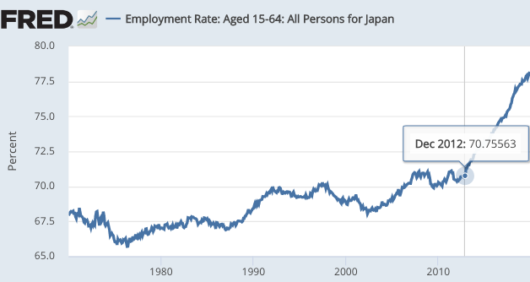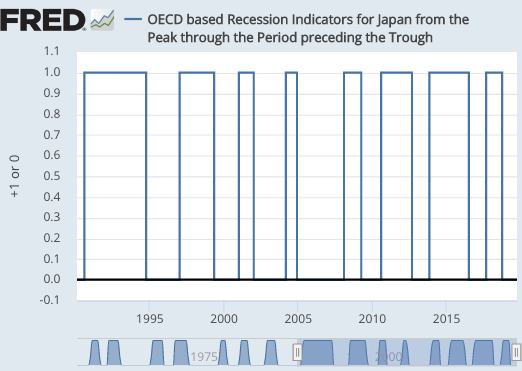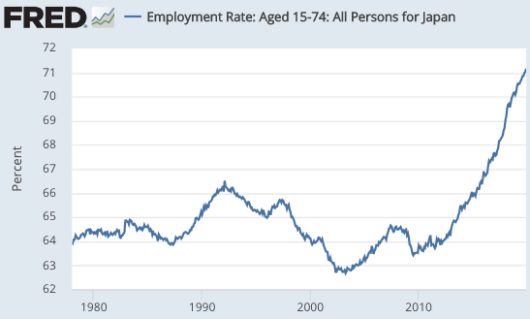Abe’s employment miracle and Japan’s meaningless “recessions”
When Abe took office at the beginning of 2013, almost no one (including me) predicted an astounding boom in employment. Prime age employment had hovered around 70% for two decades. If you had told experts that Japan would spend most of the 2010s in “recession”, they would have been even more dismissive of the claim that there was about to be an employment miracle. But Japan did spend most of the 2010s in recession:
And yet there was an employment miracle, with employment surging to 78% of the prime age population:
 And now the media is full of reports that Japan is about to enter its fourth recession of the past 10 years (during which time the US has had zero recessions.) All I can say is if these are truly recessions, then give me more and more and more of them.
And now the media is full of reports that Japan is about to enter its fourth recession of the past 10 years (during which time the US has had zero recessions.) All I can say is if these are truly recessions, then give me more and more and more of them.
PS, even if you include the 65-74 year olds, who are surging in number and tend to work less, the Japanese employment ratio is still rising:
Tags:




19. February 2020 at 14:07
Good post Scott,
But haven’t Japanese wages been very stagnant though?
https://data.worldbank.org/indicator/NY.GDP.PCAP.PP.KD?locations=JP-US
Given that employment to population ratio has increased by 11.5% and that GDP per capita has increased since Abe by roughly 8%, doesn’t that indicate that productivity has completely stagnated or maybe even fallen? Of course the aging has taken an impact, but the Japanese have not really improved their situation as of late.
19. February 2020 at 14:13
But I will admit that is a truely impressive miracle though.
Especially when you contast those numbers with the 90s.
Then again, the stagnant GDP per capita could be obscuring a composition effect where the younger folk have seen more rapidly rising wages, and the old folk are stuck with lower wages, showing no progress overall. But low wages among the old is better than no wages IMO>
19. February 2020 at 14:38
So what is it? Monetary policy? Women who are finally allowed to work? An ageing, shrinking society that needs everyone who can work. All these things together? Or something else?
Interesting: Japan now has more women working (in percentage terms) than the US.
https://fred.stlouisfed.org/graph/fredgraph.png?g=qbSC
19. February 2020 at 15:54
Japan does not have a large-scale immigration situation. If there is a nation on Earth with more social stability than Japan, I would like to know about it. A nation with tight labor markets is a happy country.
At latest count, there are 157 job openings for every job hunter in Japan. The Phillips Curve is dead, prone and flat in Japan.
There are lots of stories in Japan media about the use of robots, such as robot-only hotels. I’m not sure how serious this is as an economic factor.
Japan in fiscal 2021 will be back to running large fiscal deficits, during which the Bank of Japan conducts quantitative-easing programs. Inflation in Japan is running around 1%.
To say that orthodox macroeconomics is in a discredited shambles would be…well, generous.
19. February 2020 at 17:50
John, Good questions, I have not researched those issues.
19. February 2020 at 20:15
It is interesting that the same phenomenon in terms of increasing employment is also occurring in other countries like the UK (which by the way is still pretty open to immigration). May I speculate on the causes? Perhaps it is related to service type jobs, which need minimal training and also have low expectations on tenure. This hire and fire ease encourages companies to take on labor knowing they can shed it easily and they also don’t have to invest much in the employee. In other words the growth of commodity employees as a sector. You may say this is a bad thing as such employees have less protection, but of course an unprotected job is better than no job.
20. February 2020 at 01:47
https://theweek.com/articles/896456/1-economic-experiment-shinzo-abe-wont-try
This guy says Jaan should try heavier deficit spending. I am more inclined to money-financed tax cuts. Not sure the consumption tax (which Japan recently raised) is the right tool now.
There is no shortage of capital to invest, in Japan or globally. The problem is soft aggregate demand.
20. February 2020 at 03:50
Here’s the link to employment data for Japan at Trading Economics (this is the link to the Unemployment Rate, but see the links in the right column for Employment Rate, etc.): https://tradingeconomics.com/japan/unemployment-rate Maybe I don’t understand this data – it’s very different from the FRED data in Sumner’s blog post.
20. February 2020 at 04:45
Does housing play any role in this? Japan is famous for actually building enough housing in its metros to meet demand, and folks are still moving to Tokyo. Would the US look more similar if it had similar housing construction policies?
20. February 2020 at 04:50
I guess what I am thinking is that the US has a weird situation in which real wages are higher in high unemployment metros because housing supply is so constrained in coastal metros.
20. February 2020 at 07:39
Japan is interesting because it demonstrates one way a country deals with repaying domestic debt.
I welcome corrections and clarifications from readers.
We have watched Japan’s growth shrink but not on a per capita basis. We have observed “Debt Owed Per Capita” continue to climb. It is almost 100k per person. It is about 2.5 times GDP. I don’t know what is included in that versus US (which is about 67K per person but about 100% of GDP) —still don’t know the apples to oranges adjustment.
However, in the end—-if one takes classical economics at face value (for example—Bastiat) debt has to be repaid one way or the other.
But “Repay” is a complex concept. We are seeing one of those ways playing out in Japan now——people working longer than they used to—thus more taxes coming in. Another way, is people earning less or growth rate of earning declines——as interest on debt must be serviced and less gets paid out in social services. (All thought of in “dynamic” terms). A third way is create laws which lower future social payouts to seniors. A fourth way is to gradually lower Govt spending. (I am ignoring more extreme measures like “pay it off in 10 years”—-almost like a “wartime style economy”—-without the war part)
I assume there some optimal (defined by a democratic style of chosen utility) level of debt that people are willing to live with and that a society can reach a form of equilibrium.
I assume economists think of these kinds of issues——and maybe pols too. The real problem is when the debt is not 100k per person—-and going down—however gradually—-but if it really is 200k per person and rising rapidly.
The problem I have seen with deficit hawks is they seem to me like they have no,idea what they are talking about. But then again, that is also what I think about deficit doves.
I am curious what others might think
20. February 2020 at 08:14
Rayward, I’m not sure why that’s different, but it also shows an increase after 2012.
Burgos, Yes, but the sharp increase after 2012 is still hard to explain. They’ve had easy building rules for a long time.
20. February 2020 at 08:14
Michael, Abe’s government is improving the debt situation.
20. February 2020 at 11:40
Scott,
Almost all of the increase is female. Reasons are.
Average age of first marriage (and age of bearing children) is rising.
Average number or children per woman is decreasing so shorter average period of time required at home.
Many women have lived off their family’s accumulated wealth which has now been substantially depleted.
All of these are signs of economic weakness. If I look at the numbers, I see
Nearly all of the growth in Japan in the last 10 years has come from pushing women into the work force.
At this rate, female LFPR will max out at the male rate of 85% in 15 years…. but that would require the birth rate to go to close to zero.
Assuming even some very modest rate of procreation, female LFPR will max out in 8 or 9 years. At which point, per capita growth will drop to slightly below zero. If you factor in the aging population, per capita growth will be significantly below zero, and absolute growth will be in a free fall.
The long term issue for Japan is not who owns the assets (debt). That’s an easy problem to solve. The real problem is how Japan is going to handle the significant drop in per capita output combined with a significant increase in demand for goods and services required to support the elderly population.
20. February 2020 at 14:49
dtoh, Isn’t the solution that the elderly keep working?
20. February 2020 at 15:48
Michael Rulle: You ask very many interesting questions.
Here’s a funny one: The average Swiss resident owes about $27,000 on their national debt. The average Swiss resident also owns $100,000 in foreign sovereign bonds, through the Swiss National Bank.
Huh?
This is because the Swiss National Bank conducted a large quantitative-easing program, that is they purchased foreign sovereign bonds, to stabilize the exchange rate of the Swiss franc which they felt was rising too rapidly or had gotten too high.
Adair Turner has written interesting articles on the Japan national debt. I call the Japan national debt situation Mobius strip economics. In Japan they owe the debt to themselves, they might as well cancel it out, and I think they are. The Bank of Japan owns about half their national debt.
Orthodox macroeconomists have almost nothing interesting or insightful to say about Japan.
Another oddity: The average Japanese household has the equivalent of $32,000 in paper cash. That is, Yen in circulation in Japan is about $8,000 (equivalent) per resident.
Something else to ponder: A one-bedroom apartment in Sapporo Japan rents for about $450 a month. A one-bedroom apartment in Los Angeles rents for about $2,350 per month.
Japan citizens also pay lower taxes than us residents, in general.
In total, Japanese are actually working less hours than they used to.
20. February 2020 at 17:15
Scott,
There are actually good supply side economic solutions to the problem, but there is zero chance that they will be enacted.
So what you are left with is a good old political redistribution problem, and I think the solution will come in part as you say by making the elderly work more or longer by a) raising the age at which companies can require mandatory requirement, b) raising the age for social welfare benefits, c) reducing health care consumption by the elderly with higher prices and higher co-pays. I think you also see higher taxes on consumption and property, stricter enforcement to raise the rate of compliance in payment of social insurance payments, reductions in some areas of government spending, etc.
It will happen, you can’t distribute more than you’re produce.
21. February 2020 at 05:11
@Benjamin Cole
Interesting point on Swiss——I assume they are fiscally sound.
RE: having debt owed to yourself————I have read for years, of course, that it’s a “easy” to solve—-just cancel it. But while it is seemingly better than it being owned to others, it does not seem right to me. The government has a liability and the public has an asset. So, now the public discovers it has no asset. So I have these savings locked up in my Post Office account which are now zero. Then what?
This is very analogous—-maybe identical—-to our SS “Trust Fund”. Did you know you can go on a government website, put in your social security number, and other info and with an “account in your name” discover what is in your corner of the “Trust Fund”. The assets are “promissory notes”——I.e., promises to pay. They get the money by selling debt to the public (and from SS taxes others pay).
So, I don’t think we would say we can solve our social security problem by canceling it because “we owe it to ourselves”. So, I guess I never understood why Krugman and others think Japan’s problem is not a serious one because “they owe money to themselves”
These are more simple problems to describe (“light years” —-bad metaphor—-more simple than the problem Scott Is trying to describe—-which is why I find his ideas so interesting)—-but while they are simple to describe——-(we are not as rich as we think—is my summary description). Yet, a big yet, where are the standard markers we have a problem?
21. February 2020 at 14:13
If recession means lost output growth, then it’s it’s not “meaningless.” That labor employment has gone up is fine for the people involved (I’m assuming they wanted to work, not slaves :)), and if we are going to have a recession, I’d rather have one with less involuntary unemployment, but lost output is lost output.
21. February 2020 at 14:20
@Rulle
The way that future generations will “repay” current debt is by having a lower standard of living than they could have had if saving and investment had been higher in the present.
1. March 2020 at 00:50
You should know working age population in Japan has been shrinking. The number of working age (from 15 to 64) population was 81 million in 2012, and that in 2019 was 68.7 million.
The reason emplonment rate soars is decreasing working age population. The condition is very severe.
What’s the miracle! (in bad way)
Check websights below. https://www.soumu.go.jp/johotsusintokei/whitepaper/ja/h26/html/nc141210.html
https://career-cc.net/kisetsu-tyouseiti20194/
14. August 2023 at 23:13
Your mode of explaining the whole thing in this piece of
writing is really nice, all can easily know it, Thanks
a lot.